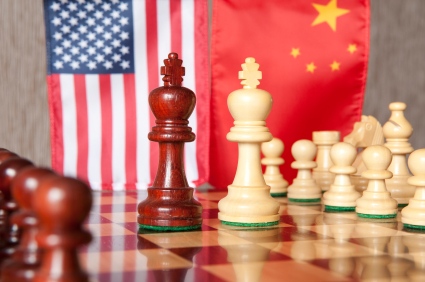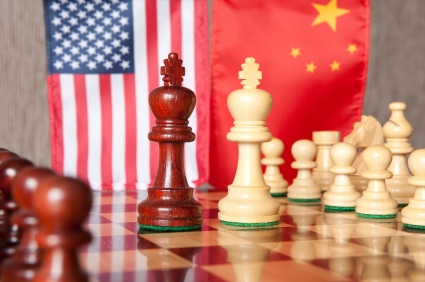 Will the new clean technology race pit the U.S. against China competitively, or allow for scientific partnerships?Cross-posted from AlterNet.
Will the new clean technology race pit the U.S. against China competitively, or allow for scientific partnerships?Cross-posted from AlterNet.
From Jan. 19 to 21, President Obama will host Chinese President Hu Jintao for their first bilateral summit this side of the Pacific. According to former National Security Adviser Zbigniew Brzezinski, this “will be the most important top-level United States-Chinese encounter since Deng Xiaoping’s historic trip more than 30 years ago.” While economic and military issues will be on the agenda, a key part of the meeting will be energy. U.S. Secretary of Energy Steven Chu has suggested that a Sputnik-like race for clean energy between China and the U.S. may be emerging. If so, how can the U.S. get in the game, given the current political climate in the country?
U.S.-China relations have been rocky over the past two years. At the United Nations climate conference in Copenhagen in 2009, China and the U.S. wound up at a standoff in the summit’s final hours.
Tensions hinge on who should take responsibility for the bulk of the emissions. The U.S. blames China, a growing economy and the world’s largest emitter of greenhouse gases, while China blames the U.S., the largest emitter historically and the larger emitter on a per capita basis, by far.
The original UNFCCC charter from 1992 stipulates that developed nations, such as the U.S., lead the world in fighting climate change, since they bear historical responsibility for producing it. The 1997 Kyoto Protocol echoes and expands this concept, calling on countries to act with “common but differentiated responsibilities,” which means while all nations are “responsible,” each nation acts according to its ability based on its level of development.
This statement has caused considerable tension between the U.S. and China. While the U.S. rejects “common but differentiated responsibility” and insists that China must step up to the plate, China believes that developed countries should take the lead.
From recent U.N. negotiations in both Copenhagen and Cancun, it is clear that the U.S. wants an agreement that has “symmetry” — one that includes reductions commitments from developed and developing countries. China, for its part, is willing to make voluntary commitments but insists that the U.S. sign on to a legally binding agreement.
Additionally, concerns at the UN climate talks revolve around how emissions reductions commitments will be monitored, reported and verified.
Closely linked to the energy issue is the problem of economic protectionism. Last September, the U.S. United Steelworkers (USW) filed a 5,800-page complaint against China with the U.S. Trade Representative, arguing that its renewable energy subsidies violated international trade regulations. The complaint followed on the heels of a call by environmental groups and politicians for higher tariffs to be imposed on China-produced high carbon imports.
In December, Obama sided with the United Steelworkers, filing a complaint with the WTO against China’s wind power subsidies and leaving Chinese officials feeling snubbed and victims of a no-win American policy.
According to Dale Jiajun Wen, a scholar at the California-based International Forum on Globalization: “The recent complaints filed by the U.S. union have further consolidated the impression by many Chinese that the U.S. has no real concern for the climate but is only using it as a China-bashing tool. The inconsistency of the U.S. climate and trade policy is too obvious to ignore.”
The protectionist tendencies continue unabated: Last week, Obama signed a military authorization law that includes a “Buy American” clause, prohibiting the U.S. Department of Defense from purchasing solar panels made in China and undoubtedly dismaying Chinese officials.
Given these tensions, it remains to be seen what agreement the U.S. and China will reach at the upcoming Washington summit. Last week, Obama announced a shuffle in his Asia and China teams at the National Security Council and State Department in an attempt to hit the reset button on U.S.-China relations.
And Energy Secretary Chu recently framed the new relationship between the U.S. and China as a “Sputnik Moment.” Referencing the first satellite launched by the Soviet Union in 1957, which demonstrated its technological advantage and led to the Cold War-era space race, Chu warned that the U.S. risks falling behind China in the clean technology race.
U.S. Secretary of Commerce Gary Locke already noticed this trend in 2009 when he said, “Ten to fifteen years from now, we’re going to be saying, ‘How did Shanghai become the Silicon Valley of clean energy?'”
Yet whether this new clean technology race pits the U.S. against China competitively, as the Cold War-era space race did, or allows for scientific partnerships between the U.S. and China remains an open question.
The new joint U.S.-China Clean Energy Research Center (CERC), which will be featured at next week’s meeting, forms one sign of collaboration. The center will facilitate joint research and development on clean energy. Priority topics include building efficiency, clean coal, carbon capture and storage, and clean vehicles. Despite this sign of cooperation, the U.S. and China have exhibited remarkably different approaches to the development of clean technology and how to transition from a fossil fuel-based economy to one predominantly reliant on renewable energy.
Although historically China has relied on coal and hydropower for its electricity, it is investing in renewable energy at breakneck speed.
Currently, 70 percent of China’s economy is coal-powered. But policy changes are afoot. Although it is not an official figure yet, China’s energy bureaucrats seek to drop coal reliance from 69 to 63 percent by 2015. According to Zhang Guobao, Director of China’s National Energy Administration, China has saved more than 300 million tons of coal in the past five years by replacing dirty and outdated thermal power plants.
Another new policy puts forth that 15 percent of China’s energy must be derived from renewable energy. In addition, China’s new energy policies focus on energy efficiency compliance, considered a green technology in China.
China’s ramped up clean technology also draws on renewable energy. A 2007 report released by the World Watch Institute stated that “China has become a global leader in renewable energy.” Its renewable energy sources encompass biomass energy (derived from sugarwastes and rice husks) and biofuel (produced mainly from corn), as well as solar and wind power. (In China, nuclear energy is not included as a renewable as it is in the U.S.)
Overall, China is the world’s biggest manufacturer of solar panels. Suntech Power in Wuxi is the world’s third largest producer of solar power. Moreover, while China produced 50 percent of the world’s solar panels in 2010, it receives about 2 percent of its total energy from solar. Under new aggressive government plans for investment in renewable energy, however, this number will likely grow rapidly. In Rizhao, a city in northern China, 99 percent of households use solar water hea
ters.
Recently, an Arizona-based company, First Solar Inc., signed a deal with China Guangdong Nuclear Solar Energy Development Co., a Chinese state-owned energy company to build one of the world’s largest solar power facilities in Inner Mongolia.
Wind power has also seen dramatic increases in China in the past five to six years. The wind industry has doubled in size each year since 2004. And as the New York Times reported just this week: “More than three times as much wind power capacity was installed in China last year than in the United States.”
Here, too, policy played a strong role. Greenpeace’s Li Yan told AlterNet that “a law required that 70 percent of wind had to be manufactured domestically. This stipulation helped to create jobs and to boost China’s wind power, which has overtaken other previous leaders, such as Denmark, Spain and Germany to take the number one spot.”
Challenges to China’s wind economy remain. According to Li Yan, “If one talks about the installation capacity, China will probably be number one by the end of this year or next year, but if we talk about wind energy that has been connected, then we are still far behind.” While installation occurs more quickly, connecting, according to Li Yan, remains slowed by the centralized state owned energy structure, which has created a bottleneck.
Li Yan’s concern pinpoints one of the potential pitfalls of the China’s implementation strategies: strong policies at the central level do not always translate well into solid implementation at the regional level.
In March, China will release the 12th Five Year Plan (2011-2015), which will set new renewable energy targets. The plan calls for deep cuts in energy-intensity and large subsidies to bring renewable energy and electric vehicles to scale. It includes both a cap-and-trade program and carbon taxes. And it requires utilities companies to meet energy-saving targets and invest electricity revenues in renewable energy. Additionally, China has announced that it will produce a nation-wide greenhouse gas inventory by 2012 — its first since 1994. Producing such an inventory of greenhouse gases requires a sophisticated ability to measure emissions from a variety of sources.
While implementation remains a challenge, many of these targets are being met. For example, China’s National Development and Reform Commission recently announced that it will meet its target of reducing total pollution by 10 percent from 2005 to 2010. Last year, the Chinese government ordered blackouts in many parts of China in order to meet another target to reduce energy intensity by 20 percent by 2010 from 2005 levels.
Thus in China, a race toward self-reliance and clean energy technology is certainly on, even if it the Sputnik Moment race itself is a U.S. construct. Chu, like China, seems to be taking the long view of the environmental and economic situation.
In the U.S., renewable energy still needs to be made cost competitive. A number of measures could help to develop and make renewable energy affordable: 1) feed-in-tariffs; 2) subsidies; 3) tax credits; and 4) state regulations provide renewable portfolio standards (RPS), that is, demand that a specific percentage of their energy, typically 4-30 percent, be derived from renewable energy sources by a specific date.
A feed-in-tariff system — the first of these incentives — allows homeowners who have installed solar panels to sell back to their utility company the excess amount of energy produced, thereby reducing their overall electric bill. As of 2009, 11 states were considering legislation to permit feed-in-tariffs in the U.S.
Subsidies in the United States often heavily favor fossil fuels. This predilection leaves renewable energy, which has been growing nonetheless, artificially gummed up in the U.S. Subsidies for renewable energy could encourage a shift in the base.
Tax credits for production of renewable energy are also extremely beneficial. Thus far, growth in wind farms has been astronomical as a result of the Recovery Act or tax credit 1603.
Michigan is second nationwide for wind manufacturing and just announced another new plant. Its success comes as a direct result of grants from the U.S. Department of Energy. Additionally, Recovery Act funds help businesses diversify into clean energy through the Clean Energy Advanced Manufacturing program. And a state law enacted by Governor Jennifer Granholm in 2008 requires 10 percent of the state’s energy to come from renewable sources by 2015. Due to these subsidies and laws, the U.S. Department of Energy projects that Michigan will create 30,000 more jobs in the wind-manufacturing sector.
The results of all this investment into wind in the U.S. are already upon us. Texas, Iowa, and California lead the country in installed wind capacity. To date, 20 percent of all energy in Iowa comes from wind; it marks the largest growth over the past year. In Texas, 25 percent of all energy comes from wind power. Wind farms in the Southwest and off the coast in the Atlantic have also ramped renewable energy sources. Across the country, wind as a source of renewable energy has increased four-fold over the past decade.
During the UN negotiations in Cancún, it was announced that the Recovery Act 1603 tax credit for renewable energy would not be extended. Peter Kelley, of the American Wind Energy Association, told AlterNet, “what this means is that the growth we have seen in wind in the past few years, which grew 20 percent in 2008 and 40 percent in 2009, is set to decrease by 45 percent due to the expiration of this tax credit.”
Kelley is not only concerned about the environment. He sees the relationship between renewable energy and the economy, and specifically, job opportunities. “The wind energy industry,” he added, “kept 85,000 people in jobs during this economic recession. As a result of this tax credit expiring, tens of thousands of layoffs will occur.”
Yet Kelley’s view that tax subsidies produce jobs differs sharply from the views of some Republicans who took control of the House of Representatives last week and were quick to dissolve the Global Warming Committee, established by Speaker Nancy Pelosi (D-Calif.) and Representative Edward J. Markey (D-Mass.) in 2007. They refer to the national energy tax not as job inducing but as a “job-killing national energy tax.”
“We have pledged to save taxpayers’ money by reducing waste and duplication in Congress,” said Michael Steel, spokesman for incoming Speaker John Boehner (R-Ohio). “The Select Committee on Global Warming — which was created to provide a political forum to promote Washington Democrats’ job-killing national energy tax — was a clear example, and it will not continue in the 112th Congress.”
It remains to be seen what results Chu’s ramped-up program will have for the economy and the environment. Given last week’s changes in the Obama administration and at the helm of the House, will the Department of Energy be able to ring in a new era committed to clean technology and renewable energy? Will it be able to be competitive in a renewable energy race?
In light of Hu Jintao’s visit to Washington, the Sputnik Moment proclaimed by Chu could herald either a new era of cooperation, or of competition.



